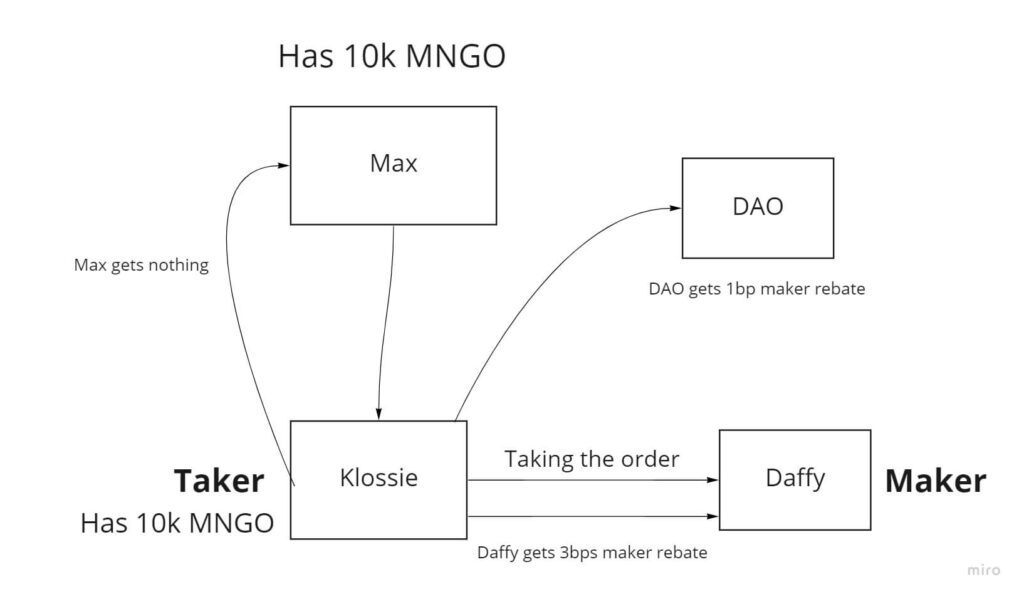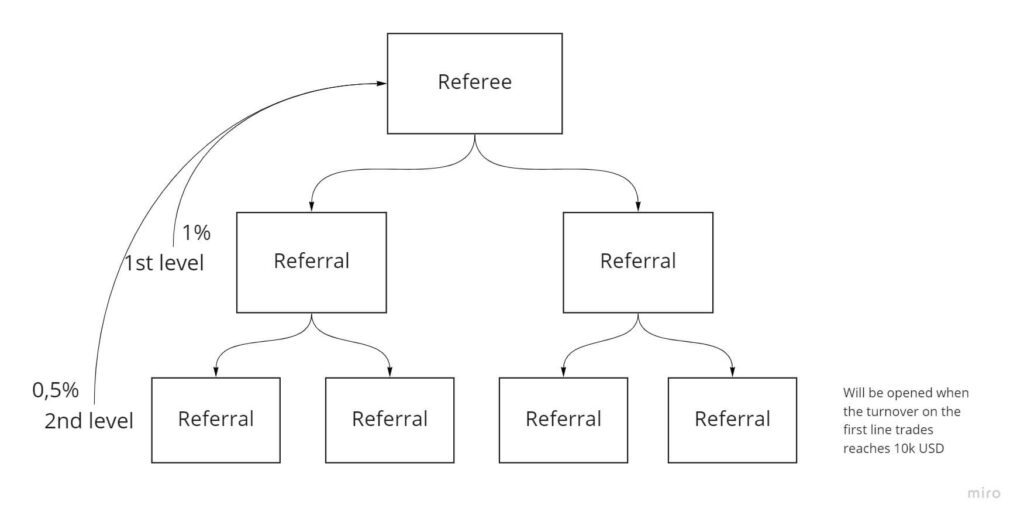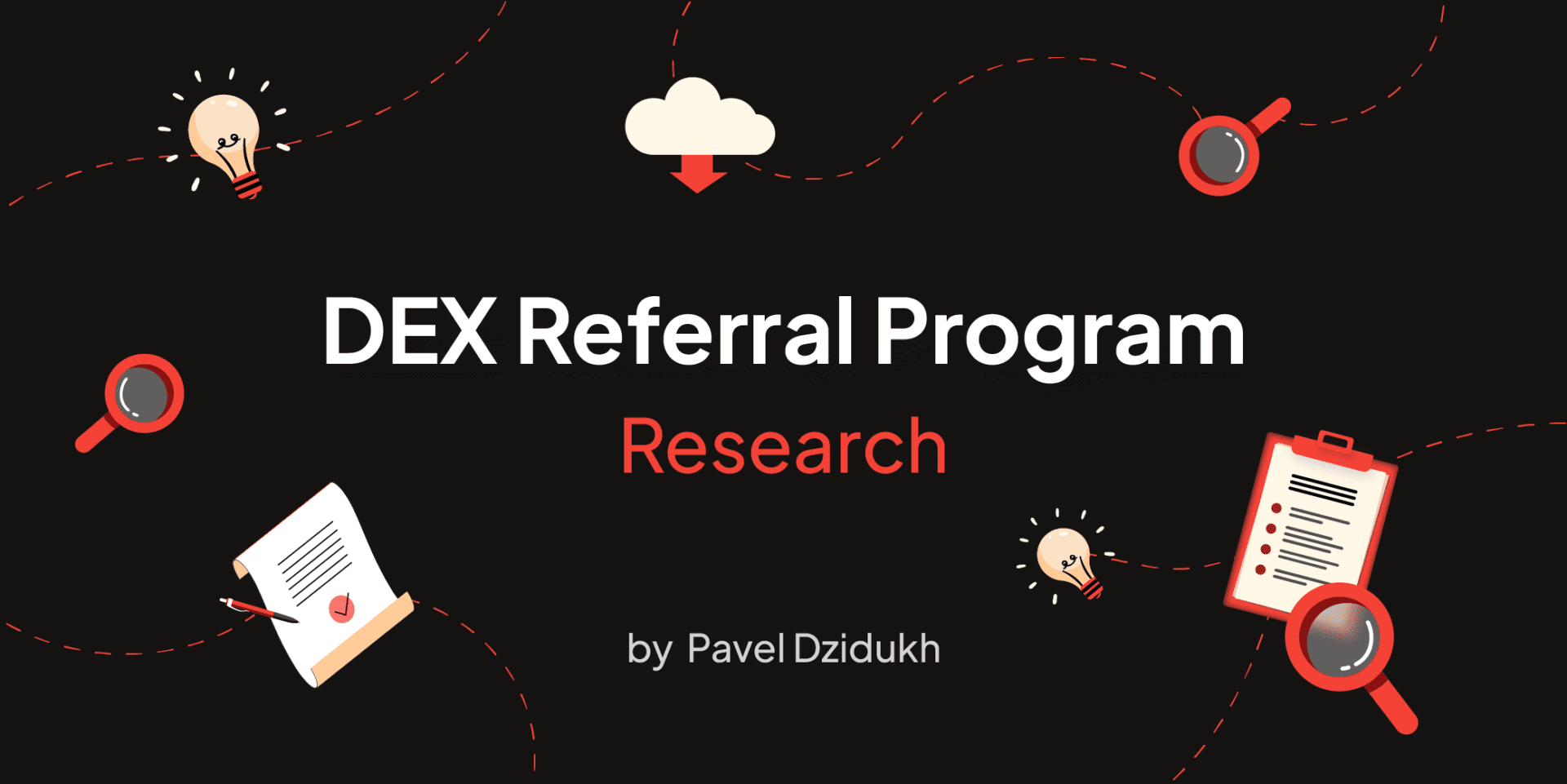Terminologies
Referral – a user referred to the platform
Referree – a user who brings other users to the platform and receives a reward for this
bps – are a unit of measurement equal to 1/100th of 1 percent
The main structure of referral systems for DEX
Mostly referral programs offered by derivatives DEX and in general DeFi protocols are linear.
Linear referral marketing – a referral model that allows you to receive direct rewards (as a percentage or fixed amounts) from the each level of the structure in depth and width. The number of available levels from which referee receives a reward depends on the specific referral program.
This model can be compared with the structure of line management, the view of the structure looks the same way
Example of a general linear structure:

Referral registration process
- The referral receives a unique link from the referee.
- The referral follows a unique link and connects the wallet.
- After connecting the wallet, the user signs a unique request that assigns the referral’s wallet (account) to the referee.
Examples of the referral systems
DYDX
Terms of the referral program:
- One-level linear referral system
- When referrals trade on Dydx, referee earn % of the trading fees, that depending on the $stkDYDX holdings on the referee’s account. stkDYDX needs to be held at ETH network linked to the affiliate DYDX account. Below is a table of fees earned based on the size of current holdings.

- For using referee’s link, referrals get a 5% discount off their DYDX fees.
- Referral rewards will be paid in USD Coin (USDC)
- There is a cap on revenue share per user – $75k per epoch
Approximately every 10 minutes we process all referral revenue for the previous 10 minutes and the revenue share tier you’re in depends on how much stkDYDX the referee has at the moment DYDX process.
Revenue share will be settled every 28 days, matching the dYdX epoch schedule.
Example: If a user pays $500K in fees during a period, the referral share would be $75K. The referral commission for this specific user would be $75K * 0.2 = $15K (assuming the referee held 0 stkDYDX)
Mango Markets
Terms of the affiliate program
- One-level linear referral system
- Mango allows to create a referral link and participate in the referral program if user have a deposit of 10k MNGO
- When referrals trade Mango Perps, referee earn 16% of their trade fees. (0.8bps on taker fees)
- For using referee’s link, referrals get a 4% discount off their Mango Perp fees. (0.2bps on taker fees)
- If referral owns 10k MNGO, he will act as a self-referral and no longer contribute to your affiliate earnings. Instead, they will pay 4bps taker fee instead of 4.8bps
Examples:
- Max has 10k MNGO, refers Klossie
- Klossie takes from Daffy
- Klossie pays 4.8bps taker fee, Daffy gets 3bps maker rebate, Max gets 0.8bps, DAO gets 1bp of revenue

2. Klossie now has 10k MNGO (LP mining / buys), takes again from Daffy:
- Klossie pays 4bps taker, Daffy gets 3bps maker rebate, DAO gets 1bp of revenue

3. Crusher has no MNGO, not referred, takes from Daffy:
- Crusher pays 5bps taker fee, Daffy gets 3bps maker rebate, DAO gets 2bps of revenue
Biswap
One of the first DEX that have launched the referral program. They have well-made referral dashboard with extended statistics for different referral areas.
Terms of the referral program
- One-level linear referral system
- When referrals trade on Biswap, referee earn minimum of 10% of the trading fees, that depending on the $BSW staked on the referee’s account.

- All the rewards are paid in BSW tokens and converted at the time of deposit to referral balance.
- Referee can withdraw rewards at any time paying a flat fee of 0.5 BSW for each withdrawal.
Biswap also allows to create several referral links that work simultaneously. Each link can be created with profit sharing up to 50%, which means that referral rewards will be partially returned to referrals.
Examples:
- Referee have 250 BSW staked in the Holder Pool meaning that your swap referral percentage is 12%. Referral made a swap for 1,000 USDT. Given his trading volume and a trading fee of 0.1%, the trade commission accounted for 1 USDT. Taking all the aforementioned into consideration, it can be concluded that swap referral reward is 0.12 USDT. Referee will receive 0.12 BSW on referral balance provided that the exchange rate is 1 BSW = 1 USDT.
- Referee have 8k BSW staked in the holder and referral link has a profit-sharing option of 50%. Invited referral made a swap on Biswap for 10,000 USDT. Given this data, we can conclude that a trading fee of 10 USDT was paid. As a result, referral reward is 0.9 USDT (10 USDT x 18% x 50%). If an exchange rate is 1 BSW = 1 USDT, referee will receive 0.9 BSW on your referral balance.
They also have referral programs for farm pools and lotteries: Farms & Launchpools. Referee gets 5% return from referrals’ earnings. Referral rewards will be visible and ready for withdrawal from referral accounts when invited referrals will withdraw BSW tokens to the wallet. Lottery. Referee gets 2% from referals’ ticket lottery purchase amount.
DerivaDEX
They’re on testnet now, but have plans about referral program launch
Conclusion
- The most obvious option for creating a referral system is a percentage reward from trading fees. When adding new structural products to the DeFi infrastructure, we can add new elements of the affiliate program, but now there is only DEX, and we start from this.
- If the project is long-term and has real tokenomics, then basically a 1-level linear referral system is created, without a large distribution in depth. If the project is DEX and the referral system has 3+ levels with a high percentage of income, then most likely it is a scam. The implementation of the referral system up to 3 levels is present on spot DEX.
- Opening a referral program for staking or holding a native platform token, as implemented by Mango, for example, looks like a good option. However, 10к MNGO at the current rate of ~$5800, which can scare away a large number of referees. A small entry threshold can increase interest in the token and encourage the referee to purchase it. So we can set a small mandatory value in the equivalent of $50-100 to activate the referral program.
- A progressive scale of growth in the percentage of trading commissions should also be implemented, as this will encourage users to hold tokens, as well as not allow too much percentage of deductions from trading commissions for all users. Only those who have acquired the maximum of SPIN will receive the maximum of the rewards. Also, a referral discount is also a good option to incentivize users and will encourage them to use affiliate links, rather than registering on their own.
- The accrual of rewards is possible in two formats:
- Converting all referral accruals into stablecoins at the time of rewards accrual.
- Converting all referral accruals into a platform token at the time of rewards accrual.
- The most successful option will be clear in the final version of tokenomics, because part of the tokens must be pledged for incentivization, which includes a referral program.
- Only scam projects implement the accrual of each affiliate reward on-chain (games like Express Smart Game, etc.). All major dexes, both spot and derivative, implement an off-chain dashboard with an account that receives referral accruals. Further, the user withdraws referral accruals from the account to his on-chain wallet.
- The referral program can be supplemented based on new products that appear within the infrastructure, but it is not recommended to change existing referral conditions. There have been many cases where even a slight change in the referral program led to significant problems in accruals.
- If there’s a plan to make a multi-level referral program, then it makes sense to open levels depending on the total turnover of the previous level. Example:

On the example, 0.5% rewards from the 2nd line will not be paid if the trading volume of all users on the 1st level is below $10k.
